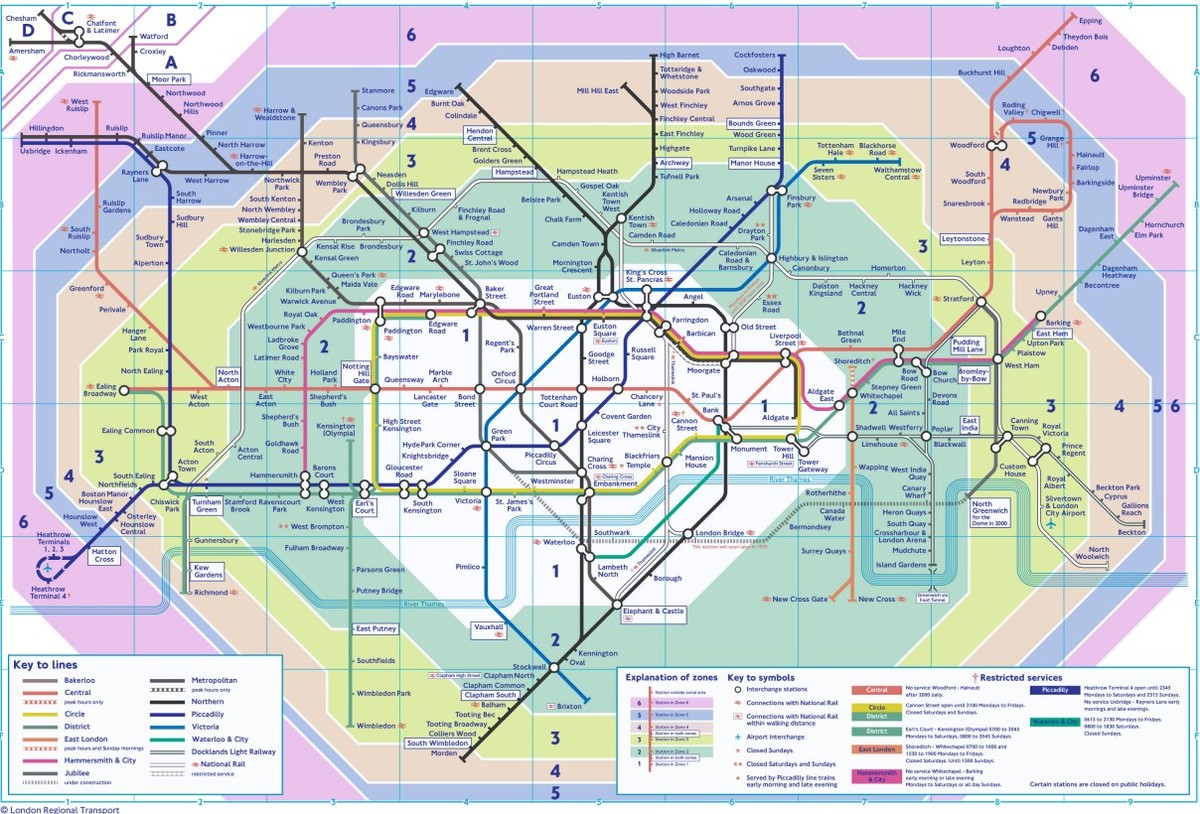Public Transportation is Convenient and Extensive
Public transportation in London is expansive and extremely convenient for travelers. London public transport network consists of the famous Underground (also known as the “tube”), buses, light rail, and commuter trains extending throughout the city and greater London area. Almost every home, office, tourist attraction, or place of accommodation is within a 5 minute walk of a bus stop, tube station, or railway station thanks to the dense network of high frequency services. Transport for London (TfL) is the single agency that oversees most transportation in London. Londoners rely heavily on public transport, with only around half of households owning a private vehicle. This is likely due to the quality, coverage, and frequency of transportation options. Buses run along 675 different routes across the city, with departures every 10-30 minutes depending on the time of day. London’s expansive rail network radiates from central termini and includes 11 Underground lines, the Docklands Light Railway in East London, and Trams in South London. The new Elizabeth Line further improves connectivity with cross-London tunnels. River transport is also available via scheduled passenger boats on the River Thames.

Getting Around by Bus or Tube
Whether using the iconic red double-decker buses or the world-famous Underground, getting around London is straightforward. The London public transport system makes it easy to navigate with maps displayed prominently in stations and on each train or bus. Routes are clearly labeled by their terminating stations so it’s simple to know when your stop is approaching. Fares can be paid using contactless payment methods like Apple Pay or via prepaid travelcards like the Oyster Card for multi-trip savings. While the tube is fastest, taking a bus allows views of London from the top deck. Be sure to sit at the front!
Payment Options for Travel
London offers several convenient options for paying fares on public transport. Visitors can purchase individual paper tickets, but for extended travel the prepaid Oyster Card provides the best value through daily and weekly fare caps. The Oyster Card is a reloadable, contactless smartcard that can be topped up with credit or cash and used to “touch in” and “touch out” of ticket barriers at stations. Alternatively, most foreign contactless bank cards and mobile wallets like Apple Pay can also be used directly without needing an Oyster Card. By capping daily charges, these options make transport significantly more affordable for tourists.
Accessibility on the Transport Networks
While London’s public transportation is excellent overall, accessibility varies between modes. The tube poses more challenges compared to other systems due to its age. Not all stations have elevators or escalators, and those that do aren’t always clearly signed. Accessibility of London’s transport can require planning extra time and effort for wheelchair users or those with limited mobility. Buses are generally the most accessible as all transfer points are street level. The DLR and Trams were designed or retrofitted for accessibility and nearly all stations have lifts. Commuter trains managed by TfL also aim to be step-free or have boarding assistance available. Overall accessibility continues improving but remains a work in progress, emphasizing the value of buses for some travelers.
24/7 Transportation Coverage
One advantage of London’s sizeable public transport networks is the frequent coverage provided even late at night. Buses run regularly throughout the day and night across the city, with frequency reduced only slightly in the small hours. Tube and rail services have more limited nighttime schedules but aim to run at least every 30 minutes to support nightshift workers and revelers. River services similarly adjust schedules to cater to evening travelers. This 24-hour operation means getting home is rarely difficult, even after midnight on a weekend. Advance planning is only needed for trips reliant on the earliest or latest trains as some lines start/cease operation before or after midnight.
Comprehensive Online Trip Planning Tools
London’s transportation is made even more convenient by online trip planning resources. In addition to printed tubes maps at stations, website Transport for London (TFL) provides real-time status of all modes. Users can enter any two locations to receive walking or public transport directions, including estimated times and journey legs by bus, tube, or train. Private journey planning sites like Citymapper and Rome2rio aggregate TFL data with additional journey options like car services or cycling routes. Apps for these planners allow downloading maps and schedules for offline use. International trip planning often requires converting locations to their London equivalents, but these digital assistants simplify exploration once arrived. between neighborhoods.
Best Ways to Maximize Transportation Value
A few tips can help visitors get the most out of London’s public transportation systems. Purchasing weekly or monthly travelcards like a 7-Day Oyster card caps fares and provides better value than individual journeys. Combining modes like a bus ride to the tube station walks the line between speed and cost. Sitting upstairs on the bus or standing on tube carriages allows photography without blocking others. And most importantly, relax and immerse in the experience of traveling through one of the world’s great cities. Efficient movement around London remains inexpensive and leaves more time and money to enjoy diverse attractions.

 Understanding the Chinese Perspective on Government and Rebellion
Understanding the Chinese Perspective on Government and Rebellion